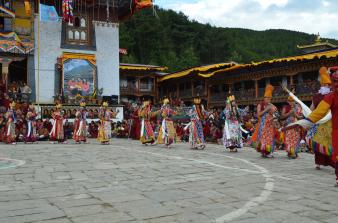 Rigma Chudruk Cham: Dance of the Sixteen Wisdom Goddesses
Rigma Chudruk Cham: Dance of the Sixteen Wisdom Goddesses
Rigma Chudruk Cham is a pacifying dance, performed solely by monks wearing exquisite costumes to represent the sixteen goddesses that make various offerings to enlightened beings. Generally, the dance has two types: Rigma Chudruk Cham and Rigma Chudruk Nga Cham. Though the costumes are identical, these dances can be easily differentiated by the instruments they use. The first Rigma Chudruk Cham performs with Drilbu, bell, and Daru or Damaru, a small two-headed drum. The latter dance exclusively plays Nga drums with Ne-tok, drum-stick. The dance is known by various names across different Buddhist traditions: Rigma Chudruk Cham; Khandro-mai Cham Dance of Dakinis; Zhe-wai Cham pacifying dance; Dorji Lhamo chudruk sixteen Vajra Dakinis; Choe-pai Lhamo Chudruk Sixteen Offering Goddesses; and Dodyon-gi Lhamo Chudruk Sixteen Pleasurable Goddesses. The sixteen goddesses not only bestow wisdom but also entertain and bring enjoyable offerings to the enlightened spiritual beings. These goddesses are generally classified into three groups: Outer, Inner, Secret Offering Goddesses. The first group consists of four members: 1. Gegmo-ma, Skt. Lasya, Goddess of Grace 2. Threngwa-ma, Skt. Mala, Garland Goddess 3. Lu-ma, Skt. Gita, Singer 4. Gar-ma, Skt. Nirti, Dancer The second group has also four members: 1. Meto-ma, skt. Pushpe, Flower Offering Goddess 2. Dhugpe-ma, Skt. Dhupa, Incense Offering Goddess 3. Nangsel-ma, Skt. Aloka, Lamp offering Goddess 4. Drichab-ma, Perfume Offering Goddess The third group has five goddesses: 1. Piwang-ma, Violin player 2. Lingbu-ma, flute player 3. Ngadum-ma, Drum player 4. Zanga-ma, Skt. Muranyyaze, Clay-drum player 5. Zuk Dorji-ma, Skt. Vajra Dakini, Vajra Form Goddess The last group has three. 1. Ro Dorj- ma, Taste Vajra Goddess 2. Rek-ja Dorji ma, Feeling Vajra Goddess 3. Choying Dorji ma, Skt. Dharmadatu Vajra Dakini, Vajra Goddess of unfabricated awareness.
#rigma chudruk
Bhutan